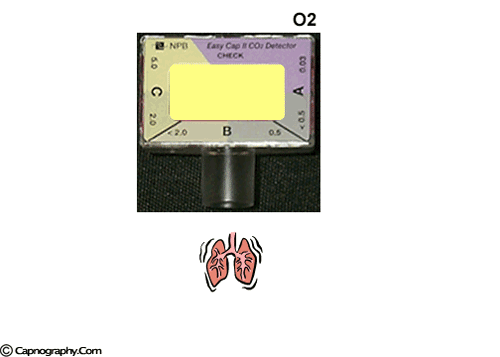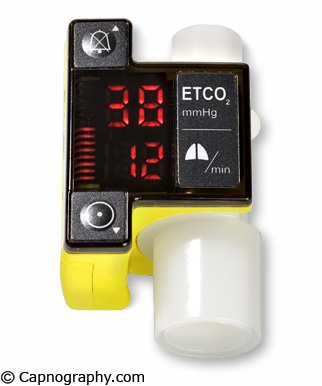Capnography in Emergency Tracheal IntubationsBhavani Shankar Kodali MD |
|
Majority of emergency intubations are performed in surroundings that are less than ideal circumstances as compared to those in operating rooms. Therefore all tracheal intubations should be confirmed for endotracheal placement. Esophageal intubation or misplaced endotracheal tube can result in unsuccessful resuscitation, or can result in worsening of cardio respiratory status.
Until recently, calorimetric devices are the only portable devices suited for this purpose. Calorimetric devices have inherent false positives and false negatives as described below. There are some battery rechargeable portable capnographs for this purpose. A major disadvantage of these modules have been warming up time required before being ready for use. However, recently a small portable quantitative capnometer with 5 second calibration time has been introduced. This unit, Capnocheck® Capnometer is described below. These units are new addition to capnography armamentarium that will encourage emergency care providers to confirm endotracheal intubation reliably. Possible applications are during field intubations, emergency room intubation and respiratory monitoring, hospital floor codes, hospital floor intubations, and intubations and respiratory monitoring in post-anesthesia care units. Intensive care units that have not realized full benefits of capnography modules can use these portable units for confirming endotracheal intubations.
Chemical method of CO2 measurement

A pH-sensitive chemical indicator is enclosed in a plastic housing and is connected to the gas stream between the endotracheal tube and the anesthesia circuit. The pH sensitive indicator changes color when exposed to CO2.1 The color varies between expiration and inspiration, as inspiration, as level increases or decreases. The color changes from purple (when exposed to room air or oxygen) to yellow (when exposed to 4% CO2). The response time of the device is sufficiently fast to detect changes of CO2 breath-by breath.1 However, this device is not very sensitive when CO2 output is low as is during CPR. Easy cap II is a an example of such pH sensitive indicator devices.
False negative results may occur even with correct endotracheal tube placement in patients in cardiac arrest, in whom sufficient CO2 may not be present in the lungs. It is also more relevant to point out the possibility of color change in the device due to agents other than exhaled carbon dioxide (false positive results). Gastric contents, mucus, and drugs such as epinephrine can cause false positive results. It is imperative that clinicians using these devices be aware of this limitation. One way to avoid this pitfall is to observe the change in color in the device with each breath. A false positive result causes a permanent color change in the device; hence, the color does not vary with ventilation.2,3
Reference:
1.O’Flaherty D, Adams AP. The end-tidal carbon dioxide detector. Assessment of new method to distinguish oesophageal from tracheal intubation. Anaesthesia 1990;45:653-5.
2.Srinivasa V, Kodali BS. Video on orotrachal intubation. NEJM 2007;357:6:620
3.Srinivasa V, Kodali BS. Caution when using colorimetry to confirm endotracheal intubation. Anesth Analg 2007;104:738
Digital Capnocheck® Capnometer

This is a small portable pocket size device that quantitatively measures CO2 concentrations and respiratory rates, when interposed across the airway. This device uses a miniaturized mainstream infra red ETCO2 technology providing CO2 measurements. Unlike other capnometers, the Capnocheck Capnometer does not need to be calibrated. The unit can be set to alarm when the ETCO2 is out of set range. The measuring range is 0-99 mmHg with an accuracy of 0-40 mmHg ± 2 mmHg, 41-99 mmHg 6%. System response time is less than 0.5 seconds. The warm up time is less than 5 seconds. The capnometer is so light weight that it can be hung around the neck and carried all the time by emergency personnel. The device operates on two AAA batteries. Although there are no formal publications using this device for emergency use, given the well authenticated application of capnography in emergent intubations, the device should be very useful.

 Twitter
Twitter Youtube
Youtube









